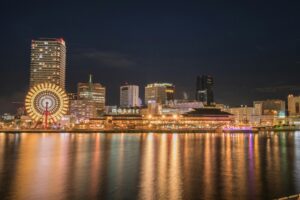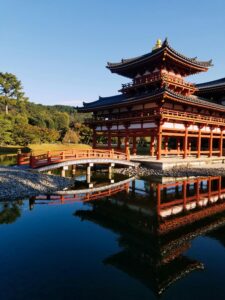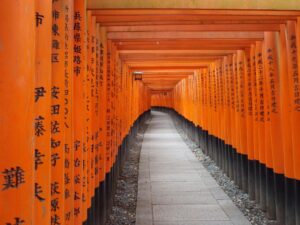Introduction to the Kamakura Great Buddha
The Kamakura Great Buddha, or “Daibutsu” as it is affectionately known in Japanese, stands as a monumental outdoor representation of Amida Buddha, one of the most famous icons of Japan. Located in the serene Kotoku-in Temple in Kamakura, this bronze statue attracts visitors from around the world due to its historical significance and striking presence.
This colossal bronze statue not only symbolizes spiritual significance but also showcases the artistic and cultural prowess of the Kamakura era. Erected in 1252, the Great Buddha has withstood the test of time, including natural disasters like tsunamis and typhoons, which adds to its mystique and reverence.
| Feature | Details |
|---|---|
| Height | Approximately 11.4 meters |
| Weight | About 121 tons |
| Material | Bronze |
| Location | Kotoku-in Temple, Kamakura |
Visiting the Kamakura Great Buddha offers a unique opportunity to delve into the spiritual and historical journey of Japan. Whether you’re interested in the architectural marvel, the spiritual significance, or simply the peaceful ambiance of the temple grounds, the Great Buddha provides a profound experience.
- Check the opening hours before visiting, as they can vary by season.
- Consider purchasing tickets in advance to avoid long lines, especially during peak tourist seasons.
- The best time to visit is early morning or late afternoon to avoid crowds and experience the statue in different lighting conditions.
For those looking to enhance their visit, local guides offer insightful tours that delve into the history of the statue, the temple, and the surrounding area. Engaging with these stories can transform a simple visit into a memorable journey through Japan’s rich cultural tapestry.
Overview of the Kamakura Great Buddha
The Kamakura Great Buddha, known as “Daibutsu” in Japanese, stands as a monumental outdoor bronze statue of Amida Buddha in the Kotoku-in Temple in Kamakura, Japan. This iconic figure not only represents a significant religious symbol but also serves as a major tourist attraction, drawing visitors from around the globe.
Constructed in 1252, the Kamakura Great Buddha is renowned for its historical and cultural significance. Originally housed in a large temple hall, the statue has withstood the test of time, including numerous typhoons and earthquakes, which eventually led to its current open-air presentation.
- Height and Structure: The statue stands approximately 13.35 meters tall and weighs around 93 tons, making it one of the largest Buddha statues in Japan.
- Historical Significance: The Kamakura Great Buddha is a testament to the artistic and religious fervor of the Kamakura period, reflecting the era’s distinct sculptural style.
- Visitor Information: The site is accessible to visitors year-round, offering a unique glimpse into the spiritual and historical essence of Kamakura.
Visiting the Kamakura Great Buddha provides an opportunity not only to admire its grandeur but also to explore the serene surroundings of Kotoku-in Temple. Whether you are interested in history, culture, or simply looking for a peaceful retreat, the Kamakura Great Buddha offers a profound experience that resonates with both the heart and mind.
| Feature | Details |
|---|---|
| Location | Kotoku-in Temple, Kamakura, Japan |
| Height | 13.35 meters |
| Weight | 93 tons |
| Material | Bronze |
| Constructed | 1252 |
For those planning a visit, it is advisable to check the latest travel advisories and operational hours, especially in light of seasonal events or maintenance activities that might affect access to the statue.
Importance in Japanese Culture and Tourism
The Kamakura Great Buddha (Daibutsu) stands not only as a monumental bronze statue but also as a pivotal symbol in Japanese culture and tourism. This iconic figure attracts visitors from around the world, drawn by its historical significance and spiritual gravitas. Situated in the serene Kotoku-in Temple in Kamakura, the Great Buddha offers a unique glimpse into the rich tapestry of Japanese history and religious practice.
Constructed in 1252, the Kamakura Great Buddha is a representation of Amida Buddha and is renowned for its resilience, having withstood numerous natural disasters over the centuries. This resilience mirrors the enduring nature of Japanese culture through the ages. The statue’s imposing presence and serene expression provide a profound experience that resonates deeply with both locals and tourists, making it a key cultural landmark.
From a tourism perspective, the Kamakura Great Buddha plays a crucial role in boosting local economies. It is a centerpiece of Kamakura’s tourism, drawing visitors who not only come to see the Buddha itself but also explore the surrounding city. Kamakura offers a variety of attractions, including traditional temples, shrines, and scenic hiking trails, which benefit from the influx of visitors to the Great Buddha.
| Visitor Impact | Economic boost to local businesses | Increase in cultural tourism |
|---|---|---|
| Cultural Significance | Symbol of resilience and endurance | Deep spiritual and historical importance |
Understanding the importance of the Kamakura Great Buddha in the context of Japanese culture and tourism highlights not only its historical and spiritual significance but also its role in promoting cultural understanding and international tourism. This dual impact enriches both the visitor experience and the cultural heritage of Japan, making the Great Buddha a key asset in Japan’s cultural and tourism sectors.
How to Visit the Kamakura Great Buddha
Visiting the Kamakura Great Buddha, a monumental outdoor bronze statue of Amida Buddha located in the Kotoku-in Temple in Kamakura, Japan, is a must for both history enthusiasts and travelers alike. This guide provides you with all the essential information to ensure a memorable and smooth visit.
Getting There: Kamakura is easily accessible by train from Tokyo. The nearest station to the Great Buddha is Hase Station on the Enoden Line, which is just a 10-minute walk away. Alternatively, you can take a bus from Kamakura Station directly to the Great Buddha.
Best Time to Visit: The Kamakura Great Buddha can be visited year-round, but the best time is during the early morning or late afternoon to avoid crowds and experience the serene atmosphere. Spring (March to May) and autumn (September to November) offer pleasant weather and scenic beauty with cherry blossoms and autumn leaves, respectively.
| Opening Hours | 8:00 AM to 5:30 PM (April to September) | 8:00 AM to 5:00 PM (October to March) |
|---|---|---|
| Admission Fee | 300 yen for adults, 150 yen for children | |
Tickets and Entry: Tickets can be purchased at the entrance. It is advisable to bring cash as credit card facilities may not be available. The area around the Great Buddha includes several small shops and eateries, perfect for grabbing snacks or souvenirs.
Local Insights: Engage with local guides or take part in a guided tour to learn more about the history and cultural significance of the Great Buddha. These tours often reveal fascinating stories and lesser-known facts about the statue and its construction.
- Check for any travel advisories or local events that might affect opening hours.
- Wear comfortable shoes as you will need to walk and possibly stand for long periods.
- Respect the cultural site by following local customs, such as removing shoes where required and maintaining silence.
By following this guide, your visit to the Kamakura Great Buddha will not only be enjoyable but also enriched with cultural knowledge and historical context, making for a truly unforgettable experience.
Best Time to Visit
Planning a trip to see the majestic Kamakura Great Buddha? Timing your visit can greatly enhance your experience. This guide will help you determine the best time to visit the Kamakura Great Buddha, taking into account weather, crowd sizes, and special events.
Weather Considerations: Kamakura experiences a temperate climate, with mild winters and warm, humid summers. The most pleasant weather is typically in late spring (April to June) and early autumn (September to November). During these months, the temperatures are comfortable, and the scenic beauty of Kamakura is at its peak, making it an ideal time for photography and leisurely tours.
Avoiding the Crowds: Like many popular tourist destinations, the Kamakura Great Buddha can get quite crowded, especially during weekends and national holidays. To avoid large crowds, consider visiting on a weekday. Additionally, early mornings or late afternoons are less crowded times of the day.
Special Events: Visiting during local festivals can be a unique and enriching experience. One notable event is the Kamakura Festival, which takes place in April. This festival features a variety of traditional activities and performances, providing a deeper insight into Japanese culture and history.
| Month | Weather | Crowd Level |
|---|---|---|
| April-June | Mild and Pleasant | Higher (Weekends) |
| September-November | Cool and Comfortable | Moderate |
| December-March | Colder, possible rain | Lower |
By choosing the right time to visit, you can enjoy the Kamakura Great Buddha in a more relaxed and personal way. Whether you’re looking to capture the perfect photo or immerse yourself in a cultural festival, planning ahead can make all the difference.
Travel Options to Kamakura
Planning a trip to see the majestic Kamakura Great Buddha? Kamakura is easily accessible from Tokyo and offers a variety of travel options to suit every type of traveler. Whether you’re looking for a quick day trip or a more leisurely exploration, here’s how you can reach this historic site.
- By Train: The most popular way to visit Kamakura is by train. From Tokyo Station, you can take the JR Yokosuka Line directly to Kamakura Station. The journey typically takes about an hour. Another option is to take the Shonan Shinjuku Line, which also provides direct access to Kamakura.
- By Car: If you prefer to drive, Kamakura is about an hour’s drive from Tokyo. Parking can be limited near the Great Buddha, so it’s advisable to arrive early or consider parking further away and taking public transport into the city center.
- By Bus: Various bus services run from Tokyo to Kamakura, offering a scenic route along the coastline. This can be a great option if you’re not in a hurry and would like to enjoy some beautiful views on your way to the Buddha.
Once in Kamakura, the Great Buddha is a short walk from Hase Station, which is just three stops from Kamakura Station on the Enoden Line. This quaint local train offers a charming ride with stunning views of the seaside and local neighborhoods.
Remember, the area around the Kamakura Great Buddha can get quite crowded, especially during peak tourist seasons. Planning your travel in advance and considering off-peak times for your visit can make your experience more enjoyable.
| Transport Option | Travel Time | Cost (Approx.) |
|---|---|---|
| JR Yokosuka Line from Tokyo | 1 hour | 920 yen |
| Drive from Tokyo | 1 hour | Cost of fuel/tolls |
| Bus from Tokyo | 1.5 hours | 1,500 yen |
Whether you choose the efficiency of the train, the flexibility of driving, or the scenic route by bus, traveling to Kamakura is an integral part of the experience. Each option offers its own unique views and conveniences, making your trip to the Great Buddha not just a visit, but a journey worth remembering.
Kamakura Great Buddha Tickets and Entry Details
Visiting the iconic Kamakura Great Buddha is a must-do for anyone traveling to Japan. This majestic bronze statue, a symbol of peace and serenity, attracts thousands of visitors each year. To ensure a smooth visit, here are the essential details about tickets and entry.
| Ticket Type | Price | Notes |
|---|---|---|
| Standard Adult | 300 Yen | Access to temple grounds and statue |
| Children (under 12) | 150 Yen | Must be accompanied by an adult |
Opening Hours: The site is open from 8:00 AM to 5:30 PM daily. It’s advisable to visit early in the morning or late in the afternoon to avoid the crowds and experience the statue in a more tranquil setting.
- Best Time to Visit: The spring (March to May) and autumn (September to November) seasons are ideal due to the pleasant weather and the scenic beauty of the surrounding gardens.
- Special Events: Look out for special events during the New Year and Obon festival, which can offer a unique cultural experience.
For those interested in the history of the Kamakura Great Buddha, it was constructed in 1252 and has withstood numerous natural disasters, standing as a testament to resilience and enduring faith. The site not only offers a glimpse into spiritual and historical aspects but also provides a picturesque setting perfect for photography enthusiasts.
Ensure to check the latest travel advisories and local guidelines before planning your visit to enjoy a safe and enriching experience at this historic monument.
Detailed History of the Kamakura Great Buddha
The Kamakura Great Buddha (Daibutsu) stands as a monumental outdoor bronze statue of Amida Buddha in the Kotoku-in Temple in Kamakura, Japan. This iconic figure not only represents a significant religious symbol but also embodies the rich history and cultural heritage of the Kamakura period.
Constructed in 1252, the Great Buddha was originally housed inside a large temple hall. However, the hall was washed away by a tsunami in the 15th century, leaving the Buddha in its current open-air setting. This event has added a layer of resilience and enduring strength to the statue’s historical narrative.
- Historical Significance: The Kamakura Daibutsu is a testament to the artistic and spiritual achievements of the Kamakura era, reflecting the period’s architectural and sculptural practices.
- Cultural Impact: Over the centuries, the Great Buddha has attracted millions of visitors, influencing both local and international perceptions of Japanese Buddhism and cultural identity.
- Preservation Efforts: The statue has undergone several restorations to preserve its structural integrity and aesthetic detail, highlighting the ongoing commitment to maintaining this historical site.
Understanding the detailed history of the Kamakura Great Buddha offers insights into the broader historical and cultural dynamics of Japan. Each restoration and study conducted on the statue provides a deeper appreciation of its significance and the enduring legacy of the Kamakura period in Japanese history.
| Event | Date | Impact |
|---|---|---|
| Construction of the Great Buddha | 1252 | Marked a significant development in religious art and architecture in Japan. |
| Tsunami Destruction | 15th Century | Transformed the setting of the Buddha, leading to its current open-air display. |
| Latest Restoration | 1960-1961 | Enhanced structural stability and aesthetic preservation. |
By delving into the history of the Kamakura Great Buddha, we not only celebrate its past but also enrich our understanding of the cultural heritage that continues to influence present and future generations.
Origins and Construction of the Kamakura Great Buddha
The Kamakura Great Buddha (Daibutsu) is not only a monumental religious icon but also a masterpiece of Japanese craftsmanship. Constructed in the 13th century, this colossal bronze statue has withstood the test of time, surviving numerous natural disasters while remaining a pivotal symbol of resilience and peace.
The construction of the Kamakura Great Buddha began in 1252 during the Kamakura period, a time marked by significant political and cultural development in Japan. Originally housed in a grand wooden temple, the Great Buddha now sits in the open air, as the temple structures were washed away by a tsunami in the 15th century.
| Year | 1252 |
|---|---|
| Material | Bronze |
| Height | Approximately 11.4 meters |
| Weight | About 121 tons |
The statue represents Amitabha Buddha and is seated in the lotus position. Despite its serene appearance, the construction process was fraught with challenges. The initial attempts to cast the statue were unsuccessful, leading to the implementation of new techniques that were groundbreaking at the time.
- Use of multiple casting techniques to achieve the final form
- Innovative methods for structural reinforcement
- Artistic detailing that reflects the Kamakura era’s cultural zenith
Today, the Kamakura Great Buddha not only serves as a significant religious site but also attracts historians, art enthusiasts, and tourists from around the world. Its enduring presence is a testament to the ingenuity and spirit of the people of Kamakura during the medieval period.
Historical Significance and Events
The Kamakura Great Buddha, a monumental outdoor bronze statue of Amida Buddha, is one of Japan’s most iconic historical landmarks. Located in the Kotoku-in Temple in Kamakura, this statue not only represents a significant religious symbol but also reflects the rich cultural tapestry of the Kamakura period.
Constructed in 1252, the Kamakura Great Buddha has withstood numerous natural disasters, yet remains standing, symbolizing resilience and eternal peace. This statue has been a focal point for various historical events, attracting pilgrims and scholars alike, who are drawn to its architectural finesomeness and spiritual significance.
- Annual Events: The temple hosts several annual events that highlight the cultural importance of the Great Buddha. These include the Kanbutsu-e (Buddha’s Birthday) in April, where locals and tourists gather to celebrate with traditional rituals and offerings.
- Special Ceremonies: Special prayer ceremonies are held during the New Year and Obon season, providing a unique experience for visitors to engage with local customs and practices.
Understanding the historical context and participating in these events offers a deeper appreciation of the Kamakura Great Buddha’s role in Japanese culture and history. Visitors are encouraged to explore these aspects during their visit, ensuring a rich and fulfilling experience that goes beyond mere sightseeing.
| Event | Date | Description |
|---|---|---|
| Kanbutsu-e | April 8 | Celebration of Buddha’s Birthday with rituals and offerings. |
| New Year’s Prayer | January 1 | Special prayer ceremony to welcome the new year. |
| Obon Prayers | Mid-August | Ceremonies to honor ancestors, featuring traditional music and dance. |
For those planning a visit, it is advisable to check the latest event schedules and opening hours to fully experience the cultural activities surrounding the Kamakura Great Buddha.
Exploring the Surroundings of the Kamakura Great Buddha
The Kamakura Great Buddha, a monumental outdoor bronze statue of Amida Buddha, is one of Japan’s most iconic landmarks. Located in the Kotoku-in Temple in Kamakura, this statue not only offers a glimpse into the spiritual and historical depth of the area but also invites visitors to explore its beautiful surroundings.
When visiting the Kamakura Great Buddha, the experience extends beyond the statue itself. The temple grounds and the nearby areas are rich with cultural and historical significance, offering a serene escape into nature and history. Here are some highlights to consider when planning your visit:
- Hase-dera Temple: Just a short walk from the Great Buddha, this temple is famous for its stunning views of the coastal city of Kamakura and its impressive array of blooming flowers.
- Kamakura’s Historical Hiking Trails: For those who enjoy a bit of adventure, the hiking trails connecting the various temples and shrines around Kamakura offer a unique way to explore the region’s history and natural beauty.
- Komachi Street: After soaking in the spiritual atmosphere, take a stroll down Komachi Street, a bustling alley known for its quaint shops, local cuisine, and vibrant atmosphere.
Each of these locations provides a different perspective on Kamakura, enhancing the overall experience of your visit to the Great Buddha. Whether you are interested in history, nature, or local culture, the surroundings of the Kamakura Great Buddha offer something for every visitor.
| Location | Details | Distance from Great Buddha |
|---|---|---|
| Hase-dera Temple | Famous for its garden and view of Kamakura. | Approx. 5 minutes walk |
| Kamakura Trails | Connects historical sites through scenic paths. | Various starting points |
| Komachi Street | Popular shopping and dining area. | 15 minutes by public transport |
Exploring the surroundings of the Kamakura Great Buddha not only enriches your visit but also connects you deeper with the history and culture of this ancient city. Make sure to allow enough time to fully enjoy each of these remarkable places.
Nearby Attractions and Cultural Sites
When visiting the iconic Kamakura Great Buddha, travelers can enhance their experience by exploring the rich tapestry of nearby attractions and cultural sites. Kamakura, a city steeped in history, offers a plethora of fascinating destinations that complement a visit to the Great Buddha.
- Hasedera Temple: Just a short walk from the Great Buddha, this temple is famous for its beautiful gardens and stunning view of the coastal city.
- Tsurugaoka Hachimangu: A major Shinto shrine in the heart of Kamakura, known for its historical significance and its role in the Kamakura Festival.
- Komachi Street: Perfect for souvenir shopping and trying local delicacies, this bustling street offers a vibrant atmosphere that contrasts with the serene experience of the Great Buddha.
- Hokokuji Temple: Known as the Bamboo Temple, this site offers a tranquil escape with its lush bamboo grove and traditional tea house.
- Zeniarai Benzaiten Ugafuku Shrine: A unique shrine where visitors wash their money (literally) in spring water, believing it will double.
Each of these sites provides a unique glimpse into the cultural and historical landscape of Kamakura, making a trip to the Great Buddha a more comprehensive cultural journey. Whether you are interested in the spiritual heritage, historical architecture, or simply the peaceful natural settings, Kamakura’s nearby attractions are sure to enrich your visit.
| Attraction | Type | Distance from Great Buddha |
|---|---|---|
| Hasedera Temple | Buddhist Temple | 0.5 km |
| Tsurugaoka Hachimangu | Shinto Shrine | 3.5 km |
| Komachi Street | Shopping Street | 3.0 km |
| Hokokuji Temple | Buddhist Temple | 4.0 km |
| Zeniarai Benzaiten Ugafuku Shrine | Shinto Shrine | 2.5 km |
Exploring these sites provides not only a deeper understanding of Kamakura’s historical and cultural significance but also a fuller, more engaging travel experience. Each location is imbued with its own story, waiting to be discovered by those who venture beyond the Great Buddha.
Local Eateries and Shopping Options Near Kamakura Great Buddha
When visiting the iconic Kamakura Great Buddha, a trip wouldn’t be complete without exploring the local eateries and shopping options that surround this historic area. Kamakura offers a variety of traditional and modern dining experiences that cater to every palate, alongside unique shopping opportunities that reflect the rich culture of the region.
Discovering Local Cuisine: Kamakura is renowned for its traditional Japanese dishes. Visitors can enjoy freshly made sushi, sashimi, and other seafood delicacies, sourced directly from the nearby sea. For those looking for something warm, the local ramen and udon noodle shops provide hearty options. Don’t miss out on trying the sweet treats like ‘dorayaki’ (red bean pancake) which are popular among locals and tourists alike.
- Tsukemono – Pickled vegetables available at small eateries near the temple grounds.
- Matcha Ice Cream – A must-try for its rich flavor and refreshing qualities, especially during the summer months.
- Shirasu-don – A bowl of rice topped with tiny white fish, a local specialty not to be missed.
Shopping for Unique Souvenirs: The streets leading to the Great Buddha are lined with shops selling a variety of goods that make perfect souvenirs. From handcrafted Buddhist amulets to intricate Japanese ceramics, there’s something to capture the memories of your visit. Local artisans often sell their crafts directly, offering visitors a chance to buy authentic, handmade products.
| Shop Type | Products | Location |
|---|---|---|
| Artisanal Crafts | Wooden sculptures, ceramic ware | Near Hase-dera Temple |
| Local Delicacies | Yatsuhashi, Manju, Matcha sweets | Along Komachi Street |
Whether you’re looking to indulge in the local cuisine or searching for that perfect souvenir, the area around Kamakura Great Buddha offers an enriching experience that complements your visit to this historic site. Make sure to allow some extra time in your itinerary to explore these local delights.
Interactive and Multimedia Content
Exploring the Kamakura Great Buddha through interactive and multimedia content not only enriches the visitor experience but also provides a deeper understanding of this iconic cultural landmark. In today’s digital age, engaging with history and culture through various media forms can transform a simple visit into a memorable journey.
One of the most effective ways to bring the Kamakura Great Buddha to life is through virtual tours. These tours allow viewers from around the world to explore the site in high definition, offering 360-degree views and narrated insights about the history and significance of the statue. This can be particularly appealing to those unable to visit in person.
Additionally, video documentaries serve as a powerful tool to convey the historical context behind the Great Buddha. These documentaries can include interviews with historians, local experts, and monks who provide personal anecdotes and scholarly information, giving viewers a comprehensive understanding of the site’s spiritual and cultural importance.
| Feature | Description |
|---|---|
| Virtual Tours | Interactive, 360-degree views of the Kamakura Great Buddha, accessible online. |
| Video Documentaries | Engaging videos featuring expert interviews and historical insights. |
For those planning a visit, integrating interactive maps can be incredibly useful. These maps not only show the location of the Kamakura Great Buddha relative to other attractions in Kamakura but also provide route options, nearby amenities, and real-time updates, making travel planning seamless and enjoyable.
Embracing these interactive and multimedia approaches not only enhances the educational value of visiting the Kamakura Great Buddha but also ensures that the information provided is accessible, engaging, and continuously updated to reflect the latest research and developments.
Virtual Tour of the Kamakura Great Buddha
Embark on a captivating virtual journey to one of Japan’s most iconic landmarks, the Kamakura Great Buddha. This majestic bronze statue, known as Daibutsu, has stood in the open air of Kotoku-in Temple since the 13th century, symbolizing peace and serenity. Our virtual tour offers a unique perspective, bringing you closer to this historical marvel from the comfort of your home.
Explore the History: The Kamakura Great Buddha is not only a testament to religious devotion but also a masterpiece of Japanese craftsmanship. Originally cast in 1252, the Daibutsu has survived numerous natural disasters, each time being restored to its former glory. This virtual tour delves into the rich history of the statue, featuring detailed narratives and historical insights that bring the past to life.
- Interactive Timeline: Trace the historical events that shaped the Kamakura period and the Great Buddha’s significance over the centuries.
- Behind-the-Scenes Insights: Learn about the construction techniques used in the 13th century, including the unique method of casting bronze statues.
Virtual Walkthrough: Our virtual tour utilizes high-resolution imagery and 360-degree video technology to simulate a real-time experience of walking around the Great Buddha. Viewers can appreciate the intricate details of the Buddha’s facial expressions and the subtle artistry of its curls, all narrated with fascinating anecdotes and lesser-known facts.
| Feature | Description |
|---|---|
| 360-Degree View | Rotate around the statue to see it from every angle. |
| Zoom-In Capability | Focus on specific details like the Buddha’s hands and the lotus pedestal. |
Local Insights and Cultural Significance: The Kamakura Great Buddha is not just an artistic achievement; it is a cultural icon that has influenced local traditions and practices. This section of the tour highlights stories from local residents and monks, providing a personal touch to the historical narrative. Discover how the Great Buddha continues to influence the spiritual and daily lives of the Kamakura community.
Join us on this virtual tour to experience the Kamakura Great Buddha in a whole new light. Whether you’re a history enthusiast, a lover of art, or simply curious about Japanese culture, this virtual experience promises to be both educational and inspiring.
Video Documentary: The Making and Preservation
The Kamakura Great Buddha, a monumental outdoor bronze statue of Amida Buddha, is one of Japan’s most iconic landmarks. This video documentary delves into the fascinating history of its creation and the ongoing efforts to preserve this cultural treasure.
Constructed in 1252, the Kamakura Great Buddha has withstood the test of time, surviving numerous natural disasters including typhoons and tsunamis. Our documentary features exclusive interviews with historians and conservation experts who explain the sophisticated techniques used in the original construction and the modern methods employed to protect the statue against the elements and the ravages of time.
Additionally, the documentary highlights the spiritual significance of the statue to the local community and visitors from around the world. It also explores the role of the Kamakura Great Buddha in Japanese culture and its influence on Buddhist art throughout Asia.
- Insights from leading historians on the historical context of the statue’s creation
- Interviews with conservation experts about the challenges of preserving the Great Buddha
- Behind-the-scenes looks at the preservation techniques and materials used
- Personal stories from local monks and visitors who have been touched by the statue’s spiritual presence
Join us as we uncover the layers of history and dedication behind the Kamakura Great Buddha, bringing to light the untold stories of this magnificent monument. This documentary is not just a tour of a historical site, but a deep dive into the heart of Japanese cultural heritage.
Local Insights and Lesser-Known Facts
While the Kamakura Great Buddha is a well-known symbol of Japan, there are many fascinating details and local insights that often go unnoticed by the typical tourist. This article aims to uncover those hidden gems and provide a deeper understanding of this historic monument.
Unique Historical Context: The Kamakura Great Buddha, or Daibutsu, is not just a statue; it’s a testament to the resilience and artistry of the Kamakura period. Constructed in 1252, the bronze statue has withstood numerous natural disasters, yet remains standing, offering a serene gaze across the Kotoku-in temple grounds.
- Secrets of Construction: Local legends suggest that the Daibutsu was originally housed in a large temple hall, which was washed away by a tsunami in the 15th century. The Buddha has been sitting in the open air ever since, which is unusual for large Buddha statues in Japan.
- Artistic Techniques: The statue’s unique construction technique involved casting the bronze in sections and then assembling them. This method was highly advanced for its time and showcases the ingenuity of craftsmen during the Kamakura period.
Local Stories and Legends: Engaging with local guides and residents often reveals enchanting stories associated with the Great Buddha. For instance, it is said that if you touch the Buddha’s toes, it brings good luck and longevity.
| Aspect | Detail |
|---|---|
| Height | Approximately 11.4 meters |
| Weight | About 121 tons |
| Material | Bronze |
Visiting the Kamakura Great Buddha offers more than just a photo opportunity; it is a chance to connect with the deep historical and cultural significance of the area. Whether you’re interested in the technical aspects of its construction or the spiritual and cultural narratives that surround it, the Great Buddha of Kamakura holds stories and secrets that are as compelling as its serene presence.
Interviews with Local Guides and Historians
Exploring the Kamakura Great Buddha offers a unique glimpse into Japan’s rich historical tapestry. To enhance your understanding and appreciation of this iconic monument, we’ve conducted exclusive interviews with local guides and historians who share their profound insights and lesser-known facts about the Great Buddha.
- Insights from Mr. Sato, a seasoned tour guide in Kamakura, on the spiritual significance of the Great Buddha and its impact on local culture.
- Historical analysis by Dr. Tanaka, a historian specializing in Japanese Buddhist art, discussing the artistic and architectural nuances of the statue.
- Personal stories from local residents about the annual events and festivals centered around the Great Buddha, highlighting community involvement and traditions.
These interviews not only deepen the narrative surrounding the Kamakura Great Buddha but also provide travelers with a richer, more engaging experience. By connecting with the voices of those who maintain and cherish this historic site, visitors can gain a more comprehensive understanding of its significance beyond its physical presence.
| Interviewee | Expertise | Key Insight |
|---|---|---|
| Mr. Sato | Local Guide | Impact of the Great Buddha on Kamakura’s spiritual life |
| Dr. Tanaka | Historian | Artistic and architectural significance of the statue |
| Ms. Kobayashi | Local Resident | Cultural festivals and community events at the site |
By presenting these unique perspectives, our content aims to offer a distinctive and informative visit to the Kamakura Great Buddha, setting our guide apart from more generic travel resources. Whether you’re a history enthusiast, a spiritual seeker, or a curious traveler, these insights promise to enrich your visit and provide a deeper connection to one of Japan’s most revered cultural landmarks.
Unique Stories and Anecdotes
While the Kamakura Great Buddha is a well-known symbol of Japan’s rich cultural heritage, there are numerous lesser-known stories and anecdotes that surround this majestic statue. These tales not only add depth to the visitor’s experience but also highlight the unique cultural significance of the site.
Local Legends: One popular story among the locals is about the time when the Great Buddha survived a tsunami in the 15th century. This event is said to have elevated the statue to a protective symbol for the people of Kamakura.
Artistic Inspiration: The Kamakura Great Buddha has inspired countless artists and poets over the centuries. Renowned Japanese poet, Yosa Buson, composed several haikus admiring the serene beauty of the statue, reflecting its influence on Japanese art and literature.
Architectural Marvel: The construction details of the Kamakura Great Buddha are as fascinating as the statue itself. Originally housed in a grand temple, it now stands in the open air, which is unusual for large Buddha statues in Japan. The reasons and history behind this architectural decision intrigue historians and tourists alike.
Personal Stories: Interviews with local guides often reveal personal connections to the site, such as family generations that have maintained the statue. These personal stories add a human element to the historical site, enriching the narrative for visitors.
Exploring these unique stories and anecdotes provides a deeper understanding of the Kamakura Great Buddha’s significance, beyond its physical and historical attributes. Such insights offer visitors a more comprehensive and intimate experience of this iconic cultural landmark.
Practical Tips for Visitors
Visiting the Kamakura Great Buddha is a profound experience steeped in history and spiritual significance. To ensure a memorable and hassle-free visit, here are some practical tips tailored for travelers exploring this iconic monument.
- Best Time to Visit: The Kamakura Great Buddha can be crowded during weekends and Japanese national holidays. For a more serene experience, consider visiting early in the morning or on weekdays.
- Getting There: The easiest way to reach the Kamakura Great Buddha is by train. Take the JR Yokosuka Line to Kamakura Station, and then enjoy a scenic 20-minute walk or a short ride on the Enoden Line to Hase Station, which is just a few minutes’ walk from the site.
- Tickets and Entry: Tickets can be purchased at the entrance. Although there is no need to buy tickets in advance, having exact change can save you time at the ticket booth.
- Opening Hours: The site is open from 8:00 AM to 5:30 PM (April to September) and until 5:00 PM (October to March). Last entry is 30 minutes before closing.
- Local Etiquette: Remember to respect the cultural and spiritual importance of the site. Dress modestly, speak softly, and follow any posted guidelines.
For those interested in the history of the Kamakura Great Buddha, guided tours are available in multiple languages. These tours offer insights into the construction, history, and cultural significance of the statue, enhancing your visit.
Lastly, don’t forget to check the local weather forecast and dress appropriately for the season, as the area can be quite windy. Comfortable walking shoes are a must. Enjoy your visit to this majestic symbol of Kamakura’s heritage!
Current Events and Festivities at Kamakura Great Buddha
Visiting the Kamakura Great Buddha is not only a journey through Japan’s rich history but also an opportunity to experience the vibrant cultural events and festivities that take place throughout the year. This iconic landmark, nestled in the heart of Kamakura, serves as a backdrop to various local celebrations that attract both tourists and locals alike.
Seasonal Festivities: Each season brings its unique events around the Kamakura Great Buddha. During the spring, the area is adorned with cherry blossoms, and traditional festivals such as the Hanami festival, where people gather to enjoy the fleeting beauty of the flowers, are a major attraction. The summer months often feature Bon Odori dances, a tribute to the ancestral spirits, with the Great Buddha providing a serene and majestic presence.
Special Events: Apart from the regular seasonal festivities, special events are organized throughout the year. These include light-up ceremonies during the autumn when the statue is beautifully illuminated after dark, offering a completely different view and atmosphere. Winter brings the New Year celebrations, where visitors can experience Hatsumode (the first temple visit of the year) and witness traditional rites and customs.
| Event | Date | Description |
|---|---|---|
| Cherry Blossom Festival | Early April | Enjoy the scenic beauty of cherry blossoms around the Great Buddha. |
| Bon Odori Dance | Mid-August | Traditional dance festival honoring ancestors. |
| Autumn Illumination | November | Evening light-up event showcasing the Buddha in a different light. |
| New Year’s Celebration | January 1st | Experience traditional New Year customs and celebrations. |
For those planning a visit, checking the local calendar for event dates and details can greatly enhance the experience. Each event not only offers a glimpse into the traditions and culture of Kamakura but also provides unique photo opportunities against the backdrop of the Great Buddha. Whether you are a history enthusiast, a cultural aficionado, or simply looking for a memorable travel experience, the Kamakura Great Buddha and its surrounding festivities offer something for everyone.
Travel Advisories and Safety Tips
When planning a visit to the iconic Kamakura Great Buddha, it’s essential to consider travel advisories and safety tips to ensure a smooth and enjoyable experience. This guide provides you with the latest information and practical advice to help you navigate your trip with ease.
- Check Local Weather: The weather in Kamakura can vary, especially during the rainy season from June to mid-July. Ensure to check the forecast and plan your visit accordingly to avoid heavy rains.
- Transportation Options: Kamakura is accessible by train from Tokyo. The nearest station to the Great Buddha is Hase Station on the Enoden Line, a short walk from the statue. Verify train schedules in advance to avoid peak hours.
- Buy Tickets in Advance: To save time and ensure entry, consider purchasing your tickets online if available. This can also help you avoid long lines at the ticket booth.
- Respect Local Customs: The Great Buddha is not only a tourist attraction but also a revered religious site. Dress modestly and follow any posted guidelines about photography or specific areas where silence is requested.
- Stay Hydrated: Especially during the summer months, it’s crucial to stay hydrated. There are several small cafes and vendors near the site where you can buy water and light snacks.
By following these travel advisories and safety tips, you can ensure that your visit to the Kamakura Great Buddha is both memorable and respectful. Always stay updated with the latest local news and advisories to make the most out of your trip.








